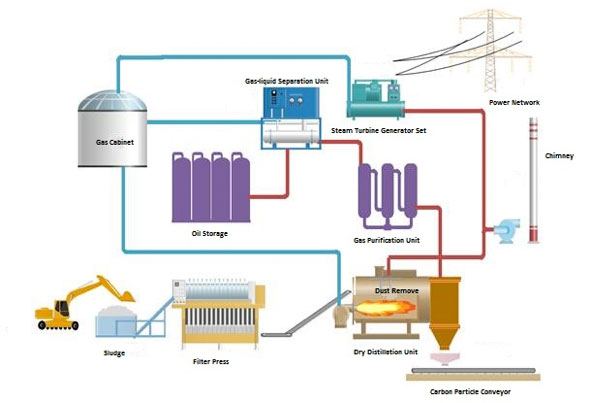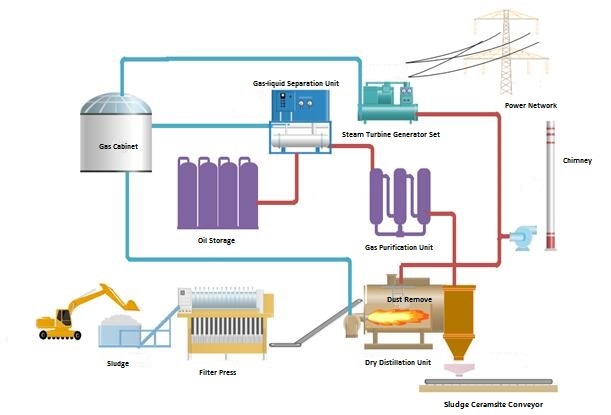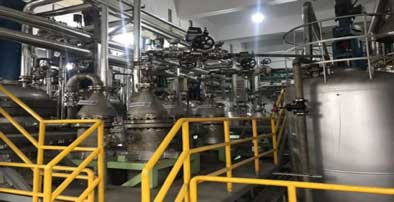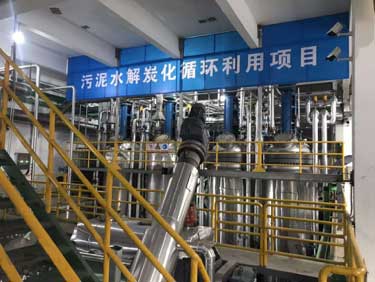Sludge treatment plant
Introduction of sludge treatment process
The sludge treatment process refers to the sludge treatment by the dry distillation method to prepare the sludge carbon particles and the sludge ceramsite. The whole set is a chemical reaction process carried out under closed, anaerobic and high temperature conditions, and the sludge is subjected to high temperature heating. Thermal decomposition produces flammable gas and material charcoal, which effectively decomposes sludge, realizes resource utilization, protects the environment, and achieves benefits.
Main Components
A sludge treatment plant is made up of several Main components:
(1) Sludge Drying Treatment Skid Mounted
(2) Sludge Dry Distillation Skid Mounted
(3) Exhaust Gas Treatment Skid Mounted
(4) Water Treatment Skid Mounted
(5) System Controlled Skid Mounted
The sludge treatment plant has the capacity on treat 20,000 tons dried sludge with a moisture content of 20% annually. The sludge treatment plant adopts a modular design. All the pry bodies are respectively installed in the 40GP container. The transportation is convenient, the land occupation is small, the adaptability is strong, and it is not affected by urban planning.
Sludge treatment key technology
The concentrated and dehydrated municipal sludge contains a large number of pathogens, parasites and harmful substances (such as heavy metals, organic compounds, etc.), and must follow the principle of “reduction, stabilization, harmlessness and resource utilization”, to avoid secondary pollution to the environment.
In the process of equipment development, the Sludge Carbonization Rotary kiln Incinerator always follows the design concept of “advanced application, safety and reliability, economical rationality, low energy consumption and energy saving”. The designed treatment capacity is 48t/d (the sludge moisture content is 20%), and the sludge carbon particles are produced. The sludge ceramsite can be adapted to 0.5~2 times of design and output change to realize “a set of equipment and two kinds of processes”, and complete the first set of equipment development and standard demonstration in China.
CONTACT US
Brief description of the main design ideas
1. The sludge carbonization and activation final temperature is about 600°C; the sludge ceramsite is fired at a final temperature of about 1150°C.
2. The main burner is arranged at the incinerator head (ie, the discharge end) to provide a part of the heat source for sludge carbonization and a main heat source for burning the sludge ceramsite.
3. The incinerator head is provided with a steam injection inlet, and the sludge is carbonized and the physical activation is achieved. The valve closes when the sludge ceramsite is fired.
4. In the pyrolysis of sludge, toxic and harmful substances (such as dioxin) will be produced. At the end of the kiln (ie, the feeding end), a second combustion chamber will be set, and the toxic and harmful substances in the pyrolysis gas will be treated by the secondary burner.
5. Designing to pass the high-temperature flue gas after combustion in the second combustion chamber into the gas-solid indirect heat exchanger disposed on the tail side of the kiln, with the purpose of effectively utilizing waste heat of flue gas for sludge pyrolysis and carbonization.
Process Flow of Sludge Treatment Equipment Plant of Sludge Carbon Particle

1. Process for Sludge Carbon Particles Production
(1) Process Parameters for Sludge Carbon Production
|
S.N. |
Project |
Unit |
Parameter |
Remarks |
|
1 |
The amount of sludge feed |
t/h |
2 |
Water content 20% |
|
2 |
The amount of fuel consumption |
Nm3/h |
20 |
Biogas or natural gas |
|
3 |
Final temperature of carbonization |
℃ |
600 |
|
|
4 |
Exhaust fuel gas amount |
Nm3/h |
5500 |
|
|
5 |
Inlet temperature of gas solid heat exchanger |
℃ |
900 |
|
|
6 |
Outlet temperature of gas solid heat exchanger |
℃ |
620 |
|
|
7 |
Sludge carbon production |
t/h |
1.06 |
53% |
|
8 |
Steam consumption |
20kg/h |
||
|
33m3/h |
0.3Mpa (saturated) |
|||
|
9 |
Activated carbon production |
t/h |
0.96 |
(2) Brief introduction of sludge ceramsite production process
The sludge cake from the plate-frame filter press is unloaded into the receiving hopper by a conveyor or a forklift, conveyed to the crusher by a belt conveyor and broken to a certain size, and the crushed material is sent to the drying sludge bin for storage by a belt conveyor, and then transferred to the carbonation unit by weighing and feeding cutter to bake the sludge charcoal, which is passed into the kiln head. The water vapor is physically activated, and then transported to the carbon storage and transportation after cooling.
The final temperature of sludge carbon production is controlled at 600℃. Because of the high calorific value of sludge, the pyrolysis gas of sludge itself will be used as the main heating source in the roasting process. The main burner at the kiln head will supply the heat source, and the secondary burner installed in the secondary combustion chamber will eliminate some toxic and harmful substances in the pyrolysis gas and waste gas. Gas-solid indirect heat exchanger is installed in the kiln to provide heat for sludge pyrolysis and carbonization. The flue gas after heat transfer is fully heated by the external heat transfer oil heat exchanger for the use of the front-end sludge treatment process, and then discharged by desulfurization and dust removal.
Environmental protection implements Taihu Basin ultra-low emission standard.
2.Sludge ceramsite production process

(1)Thermal parameters of sludge ceramsite production
|
S.N. |
Project |
Unit |
Parameter |
Remarks |
|
1 |
Sludge consumption |
t/h |
2 |
Water content 20% |
|
2 |
Consumption of Bentonite |
t/h |
0.71 |
Water content 10% |
|
3 |
Consumption of fly ash |
t/h |
0.97 |
Water content 1% |
|
4 |
Fuel consumption |
Nm3/h |
40 |
Biogas or natural gas |
|
5 |
Calcination temperature |
℃ |
1150 |
|
|
6 |
Exhaust fuel gas amount |
Nm3/h |
8500 |
|
|
7 |
Inlet temperature of gas solid heat exchanger |
℃ |
960 |
|
|
8 |
Outlet temperature of gas solid heat exchanger |
℃ |
700 |
|
|
9 |
Sludge ceramsite production |
t/h |
2.46 |
(2)Brief introduction of sludge ceramsite production process
The sludge cake from the plate-frame filter press and the purchased bentonite are unloaded into the corresponding hopper by forklift or conveyor respectively. The sludge cake is crushed into the crusher by belt conveyor and sent to the drying sludge bin for storage by belt conveyor. The purchased bentonite is sent directly to the bentonite bin without crushing by belt conveyor. The purchased coal ash is directly stored in the fly ash bin by pneumatic conveying. Sludge in raw sludge ceramsite: bentonite: fly ash ratio is 5:2:3, after accurate measurement, it is conveyed to the mixer for full and uniform mixing, then extruded and granulated by the counter-roller granulator, and then conveyed to the carbonation plant to sinter the formed ceramsite by feeding cutter, and then cooled to the storage of ceramsite, and transport outside.
The final temperature of sludge ceramsite production is controlled at about 1150℃, and the calorific value of sludge itself is not enough to complete the calcination of sludge ceramsite. Therefore, the calcination of sludge ceramsite is mainly realized by the main burner at the kiln head, and the toxic and harmful substances in the pyrolysis gas and waste gas are eliminated by the secondary burner installed in the secondary combustion chamber, and the high temperature waste gas is finally burned. The gas-solid indirect heat exchanger installed in the kiln provides heat for drying and heating the sludge ceramsite. The flue gas after heat transfer is fully heated by the external heat transfer oil heat exchanger for the use of the front-end sludge treatment process, and then discharged by desulfurization and dust removal.
Environmental protection implements ultra-low emission standards for Taihu basin.
Plant site
On December 31, 2018, China’s first sludge dry distillation and carbonization equipment developed and designed by LCDRI was successfully put into use in Huzhou Wastewater Treatment Plant adjacent to Taihu Lake.

The sludge treatment plant adopts a modular design and is divided into a drying zone, a carbonization zone, a calcination zone and an activation zone. Annually processing 20,000 tons of dry sludge with a moisture content of 20% to achieve sludge carbonization, activation, calcination of ceramsite, etc. The product sludge granule size range is 3~20mm, and the loose bulk density is 600~1500kg/m3. The cylinder pressure strength is 1.5~4 MPa, the activated carbon iodine value reaches 400~600mg/g, and the environmental protection index is superior to the national emission standard.

